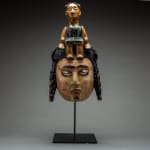Ibibio Colonial Polychrome Dance Mask, 20th Century CE
Painted Wood
height 45.7 cm
height 18 in
height 18 in
PF.6125
Further images
The Ibibio have no centralized government, so their daily life is controlled by secret societies. One of the most important, the Ekpo society, plays an active role in political, judicious,...
The Ibibio have no centralized government, so their daily life is controlled by secret societies. One of the most important, the Ekpo society, plays an active role in political, judicious, and religious affairs of a village. They are also in charge of the ancestor cult and initiation of young people. For the all-important ritual of initiation, two basic types of masks are used: the Idiok, representing wandering spirits, and Mfon depicting spirits that have reached paradise. An initiate who wears a mask, such as this dramatic example, personifies the spirit who has returned to earth for a brief time. Masks have the wonderful ability of presenting very human qualities in a larger than life format. They are unique in the world of art in their expression of complex emotions directly related to a particular event or ceremony. This very delightful mask shows a Western influence in the facial features, and in the use of paint that the Europeans introduced. This mask depicts an unusual subject: a miniature woman with attached arms sits atop the head of a European woman. The “flesh” of the mask has been painted with a pink flesh tone and her “hair” is highlighted in black and braided into two pigtails that fall over her ears. Her open mouth reveals a row of white teeth framed by her bright red lips. Clearly, this woman is a European, perhaps imitating a missionary or the wife of an important merchant. More likely, she is symbolic of European culture as a whole, for she appears both attractive and yet slightly ominous. The miniature woman who sits upon her head wears a black dress decorated with red and white dotted highlights. Her hair has been braided into three central crests, a typical coiffure indicative of African nobility. She appears sweet and compassionate as we gaze into her clearly defined eyes. However, red spots cover her neck and face, either representing ceremonial body painting or else the effects of an ailment that might have been introduced by Europeans. The mystery of this mask cannot be properly understood for what an integral part of an elaborate ceremony invoking the spirits of the dead has been removed from its ritual context. Although this mask is but a shell of a significant religious relic, we can readily appreciate its striking beauty even if we cannot fully comprehend its spiritual significance.







